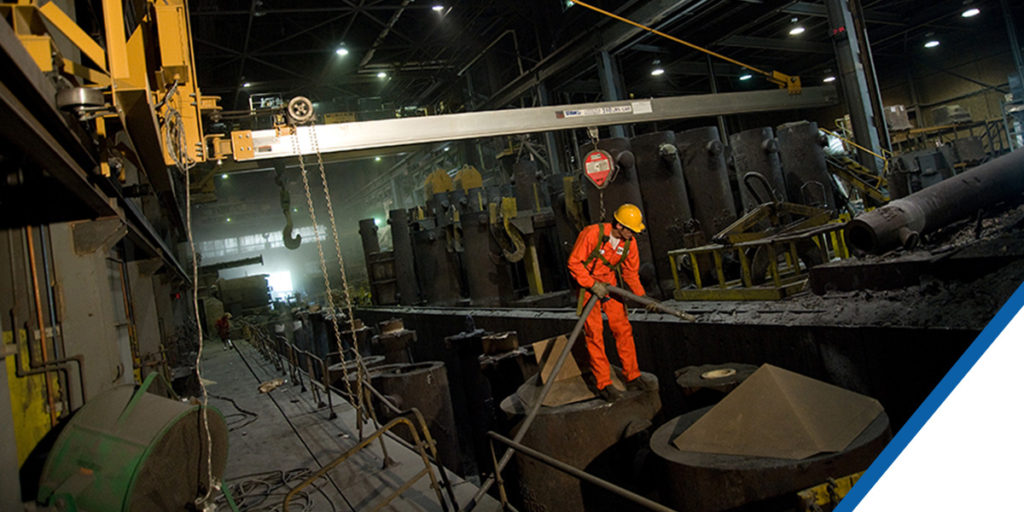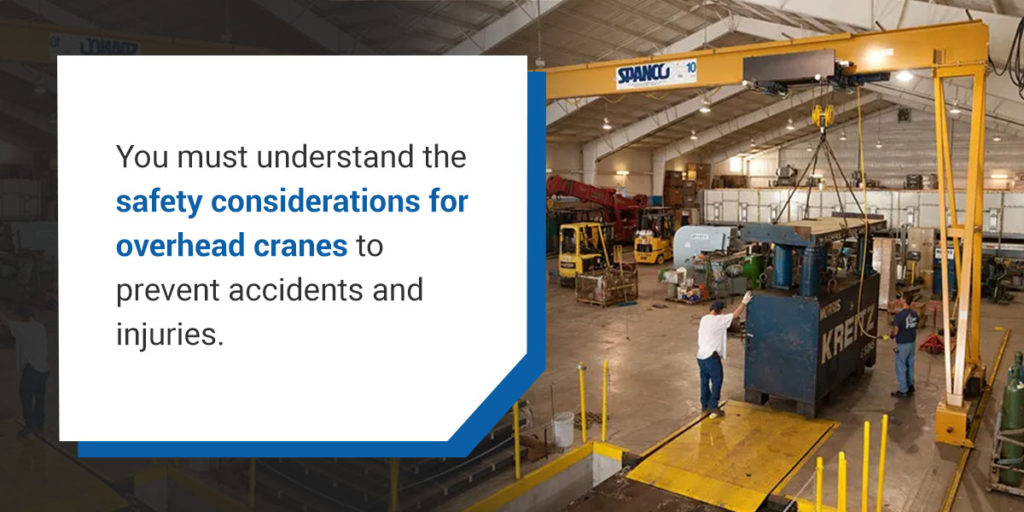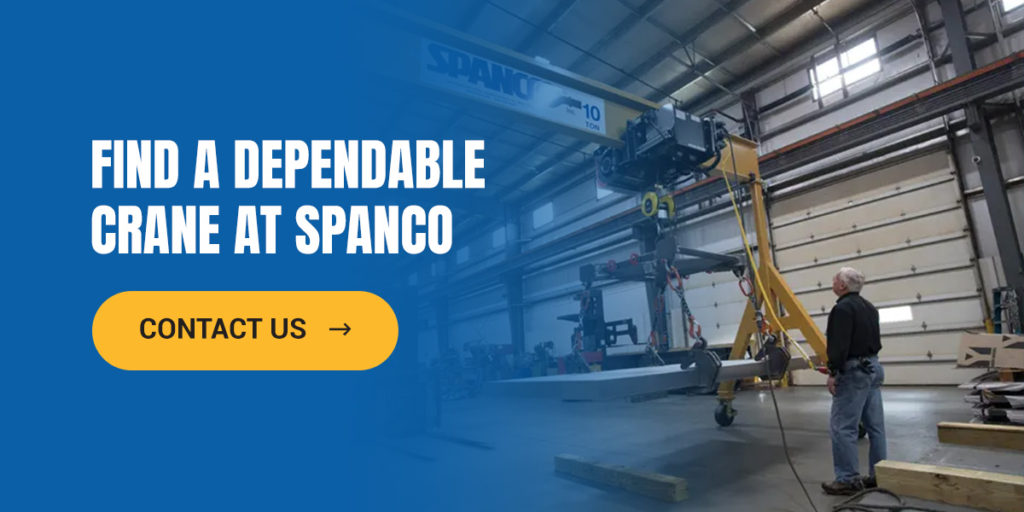
Disadvantages of DIY Overhead Cranes
Aug 3, 2023
DIY overhead cranes can seem appealing for small businesses or hobbyists looking to save money on material handling equipment. However, there are several disadvantages to building your own crane that you should pay attention to. Join us here as we explore some of the most significant drawbacks of DIY cranes, including safety risks, lack of customization options, and potential legal and insurance issues. Understanding these disadvantages can help you understand why a professionally built overhead crane is better for material handling.
Common DIY Crane Building Methods
People use several methods to build their own overhead cranes. One popular approach is to use steel I-beams as the main structural components. I-beams are relatively easy to find and can be cut to the desired length with a saw. The beams are then bolted together to create the crane’s frame, with additional steel plates to reinforce the joints. A hoist and trolley system can be attached to the I-beams to complete the crane.
Another common method is to use wood as the primary material for the DIY crane. Hobbyists or those with limited access to metalworking tools often use this approach. The crane is built using large wooden beams cut and assembled to form the frame. A chain hoist or come-along is used to lift and move loads, and the crane can be mounted on wheels or a track system for added mobility.
In some cases, people use repurposed materials to build DIY overhead cranes. For example, an old shipping container can be modified and reinforced to create a sturdy crane frame. Other materials that can be repurposed include old machinery parts, such as gears or axles.
While these methods can effectively create a functional overhead crane, there are several disadvantages to building your own crane rather than purchasing a premade one.
Why DIY Cranes Aren’t a Great Idea
Read on to learn more about the drawbacks of DIY overhead cranes and why leaving the crane building to professionals is your best bet.
They’re Less Safe
The most significant disadvantage of DIY overhead cranes is that they’re often less safe than commercial cranes due to the lack of engineering and safety features. Commercial cranes are designed and tested to meet strict safety standards, while DIY cranes are often built without the same level of expertise and oversight. This can lead to accidents and injuries, which can be costly and dangerous.
They’re Not Customizable
Another disadvantage of building your own crane is you’ll miss out on customization options. Commercial cranes can be personalized to meet specific needs, such as lifting capacity, height, and reach. DIY cranes, on the other hand, are often limited by the tools and materials available to the builder. This can make them less useful in certain applications and may require additional time and money to modify or upgrade.
They May Create Legal or Insurance Issues
In addition to safety and customization concerns, there may be legal and insurance issues to consider when using a DIY crane. DIY overhead cranes may not meet safety standards or be covered under liability insurance policies, which can leave the builder and user responsible for any accidents or injuries that occur. This can pose a significant risk for businesses or individuals who rely on the crane for material handling.
They’re Time-Consuming and Expensive
Finally, building a DIY overhead crane can be a time-consuming and costly process. While the initial cost of materials may be lower than purchasing a commercial crane, the time and effort required to design, build, and test the crane can add up quickly. This can take away from other tasks and responsibilities and may not be worth the savings in the long run.

Safety Considerations for Overhead Cranes
Overhead cranes are an essential tool for material handling in many industries, but they can also pose significant safety risks if not used properly. You must understand the safety considerations for overhead cranes to prevent accidents and injuries.
Proper Training
Proper training is one of the most important safety considerations for overhead cranes. Anyone who operates an overhead crane should be trained and certified to do so. This includes understanding the crane’s controls, load capacity, and safety features. Operators should also be aware of the potential hazards associated with overhead cranes, such as swinging loads, pinch pints, and electrical hazards.
Regular Maintenance and Inspection
Another safety consideration is regular crane maintenance and inspection. Overhead cranes should be inspected and maintained regularly to ensure they’re in good working condition. This includes checking for any signs of wear and tear, such as cracks in the structure or frayed cables. Any issues should be addressed immediately to prevent accidents or equipment failure.
Proper Load Handling
Proper load handling is also essential for overhead crane safety. Loads should be appropriately secured and balanced before lifting, and operators should know the crane’s load capacity. Overloading it can lead to structural failure and accidents.
Safety Features
Finally, it’s important to have proper safety features in place for overhead cranes. This includes emergency stop buttons, warning lights, and audible alarms. These features can help prevent accidents and alert operators to potential hazards.
In addition to these safety considerations, overhead crane operators must follow specific safety guidelines and regulations. For example, the Occupational Safety and Health Administration (OSHA) has particular rules for overhead cranes, including requirements for training, inspections, and load capacity.
By prioritizing safety, overhead cranes can be a valuable tool for material handling without posing unnecessary risks to workers or equipment.

Find a Dependable Crane at Spanco
While you may be tempted to build your own crane instead of buying one to save money, there are several reasons why it’s not a good idea. Safety concerns, lack of customization options, legal and insurance issues, and the time and expense involved in a DIY overhead crane all point to the benefits of buying a professionally made commercial crane instead. By choosing a commercial crane, you can ensure your material handling needs are met safely and effectively without the added risks and costs of a DIY project.
Prioritizing safety and efficiency is key when it comes to overhead crane operation, and premade commercial cranes can provide both. At Spanco, we manufacture gantry cranes, workstation bridges, and jibs to meet a multitude of industry needs. Certified welders build our cranes to comply with all applicable safety standards to give you peace of mind. We also provide excellent customer service, including assistance with crane selection, installation, and maintenance.
Save time, money, and stress by opting for one of Spanco’s expertly built overhead cranes. Contact us today to learn more!
Categories
Share this post
Contact us
Looking for the perfect fall protection equipment? Let us help!
